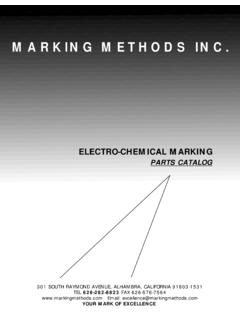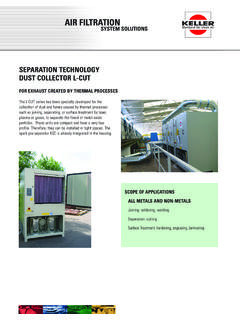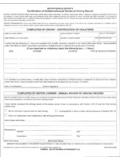Transcription of Material Safety Data Sheet - MARKING METHODS, …
1 Material Safety data Sheet1. Product and company identificationCleaner Formula APCC onforms to ANSI Standard - united states , Canada, MexicoDateVersion::305/15/2012 Product nameCleaner Formula APCC leaning uses::MSDS authored byKMK Regulatory Services Inc.:In case of emergency:Supplier/Manufacturer: MARKING Methods, S. Raymond AvenueAlhambra, CA 91803-1531 Tel: (626)282-8823 CHEMTREC, : 1-800-424-9300 International: +1-703-527-3887 Dermal contact. Eye contact. Inhalation. word2. Hazards identificationRoutes of entryPotential acute health effectsNo known significant effects or critical irritating to the known significant effects or critical irritating to the !MAY CAUSE EYE AND SKIN IRRITATION.::::::: status:While this Material is not considered hazardous by the OSHA Hazard CommunicationStandard (29 CFR ), this MSDS contains valuable information critical to thesafe handling and proper use of the product.
2 This MSDS should be retained andavailable for employees and other users of this chronic health effectsCarcinogenicity:No known significant effects or critical :No known significant effects or critical :No known significant effects or critical effects:No known significant effects or critical effects:No known significant effects or critical effects:No known significant effects or critical signs/symptomsIngestion:No specific :Adverse symptoms may include the following:irritationrednessInhalation:No specific :Amber. [Light]Emergency overviewHazard statements:Precautionary measures:Avoid contact with eyes, skin and clothing. Wash thoroughly after Formula APC2. Hazards identificationSee toxicological information (Section 11)Medical conditionsaggravated by overexposureNone known.
3 :Eyes:Adverse symptoms may include the following:irritationwateringredness3. Composition/information on ingredientsThere are no ingredients present which, within the current knowledge of the supplier and in the concentrationsapplicable, are classified as hazardous to health or the environment and hence require reporting in this out mouth with water. Do not induce vomiting unless directed to do so by medicalpersonnel. Never give anything by mouth to an unconscious for and remove any contact lenses. Immediately flush eyes with plenty of waterfor at least 20 minutes, occasionally lifting the upper and lower eyelids. Get medicalattention if symptoms case of contact, immediately flush skin with plenty of water for at least 20 medical attention if symptoms exposed person to fresh First aid measuresEye contactSkin contactInhalationIngestionNo specific treatment.
4 Treat to physician:::::Protection of first-aiders:No action shall be taken involving any personal risk or without suitable training. It maybe dangerous to the person providing aid to give mouth-to-mouth an extinguishing agent suitable for the surrounding Fire-fighting measuresExtinguishing mediaNo specific fire or explosion protectiveequipment for fire-fightersFire-fighters should wear appropriate protective equipment and self-contained breathingapparatus (SCBA) with a full face-piece operated in positive pressure mode.:Special exposure hazards:None :Not suitable:Hazardous thermaldecomposition products:Thermal decomposition may release acrid of the product:Provide adequate ventilation. Put on appropriate personal protective equipment (seeSection 8).
5 Environmental precautions6. Accidental release measures:Avoid dispersal of spilled Material and runoff and contact with soil, waterways, drainsand sewers. Inform the relevant authorities if the product has caused environmentalpollution (sewers, waterways, soil or air).Personal precautions:Dilute with water and mop up if water-soluble. Alternatively, or if water-insoluble, absorbwith an inert dry Material and place in an appropriate waste disposal container. Disposevia a licensed waste disposal spill:Methods for cleaning up2/7 Cleaner Formula APC6. Accidental release measuresPrevent entry into sewers, water courses, basements or confined areas. Wash spillagesinto an effluent treatment plant or proceed as follows. Contain and collect spillage withnon-combustible, absorbent Material sand, earth, vermiculite or diatomaceous earthand place in container for disposal according to local regulations (see Section 13).
6 Dispose via a licensed waste disposal contractor. Contaminated absorbent Material maypose the same hazard as the spilled product. Note: see section 1 for emergency contactinformation and section 13 for waste spill:Store in accordance with local regulations. Store in original container protected fromdirect sunlight in a dry, cool and well-ventilated area, away from incompatible materials(see section 10) and food and drink. Keep container tightly closed and sealed until readyfor use. Containers that have been opened must be carefully resealed and kept uprightto prevent leakage. Do not store in unlabeled containers. Use appropriate containmentto avoid environmental on appropriate personal protective equipment (see Section 8). Eating, drinking andsmoking should be prohibited in areas where this Material is handled, stored andprocessed.
7 Workers should wash hands and face before eating, drinking and contact with eyes, skin and clothing. Empty containers retain product residue andcan be Handling and storageHandlingStorage::8. Exposure controls/personal protectionNot required under normal conditions of use. Respirator selection must be based onknown or anticipated exposure levels, the hazards of the product and the safe workinglimits of the selected respirator. Ensure a MSHA/NIOSH-approved respirator orequivalent is eyewear should be used when there is a likelihood of exposure. Recommended: Safety glasses with side protective equipment for the body should be selected based on the task beingperformed and the risks involved and should be approved by a specialist before handlingthis product.
8 Recommended: Lab protectionEyesSkinRespiratoryConsult local authorities for acceptable exposure limits.:::Use gloves appropriate for work or task being performed. Recommended: Naturalrubber (latex).Hands:No exposure limit value measures:No special ventilation requirements. Use process enclosures, local exhaust ventilation orother engineering controls to keep worker exposure to airborne contaminants below anyrecommended or statutory measures:Wash hands, forearms and face thoroughly after handling chemical products, beforeeating, smoking and using the lavatory and at the end of the working period. Ensure thateyewash stations and Safety showers are close to the workstation monitoringprocedures:Personal, workplace atmosphere or biological monitoring may be required to determinethe effectiveness of the ventilation or other control measures and/or the necessity to userespiratory protective exposurecontrols.
9 Emissions from ventilation or work process equipment should be checked to ensure theycomply with the requirements of environmental protection exposure limitsNo exposure limit value exposure limits3/7 Cleaner Formula APC100 C (212 F) to 100 C (32 F)1>1 [Air = 1]Not in [Light]Boiling/condensation pointMelting/freezing pointNot Physical and chemical propertiesPhysical stateMolecular weightpHCritical temperatureRelative densityVapor pressureVapor densityVolatilityOdor thresholdEvaporation rateViscosityIonicity (in water)Dispersibility propertiesSolubilityPhysical/chemicalpro perties commentsOdorTasteColorNot formula:::::::::::::::::::::Flash point:Not available.:Auto-ignition temperatureFlammable limits:Not timeNot applicable.
10 :Burning rate:Not :Not product is or incompatible with the following materials: oxidizing normal conditions of storage and use, hazardous decomposition products shouldnot be specific Stability and reactivityChemical stabilityConditions to avoidIncompatible materialsHazardous decompositionproducts::::Possibility of hazardousreactions:Under normal conditions of storage and use, hazardous reactions will not Toxicological informationAcute toxicityChronic toxicityIrritation/CorrosionSkin:There is no data is no data is no data available. 4/7 Cleaner Formula APC11. Toxicological informationCarcinogenicityMutagenicityTe ratogenicityReproductive toxicityEyesRespiratory::SensitizerSkinR espiratory::There is no data is no data is no data is no data is no data is no data is no data is no data Ecological informationEcotoxicity:No known significant effects or critical ecotoxicityPersistence/degradabilityTher e is no data is no data generation of waste should be avoided or minimized wherever possible.



